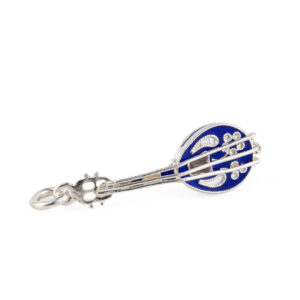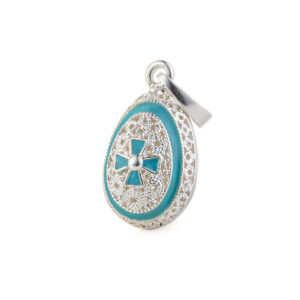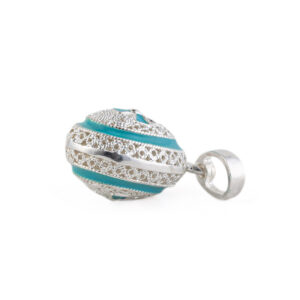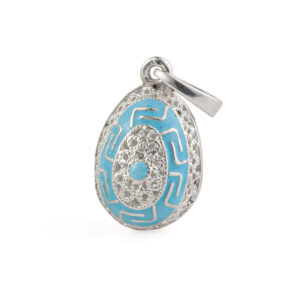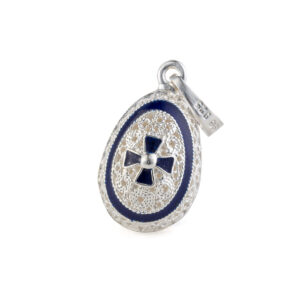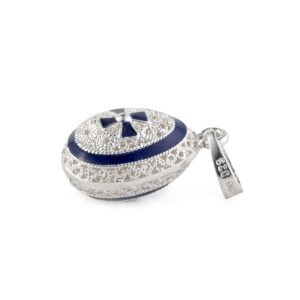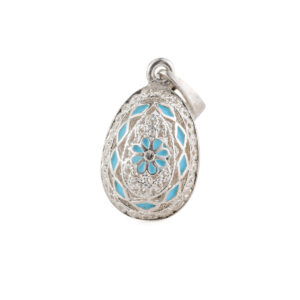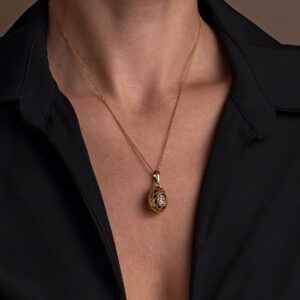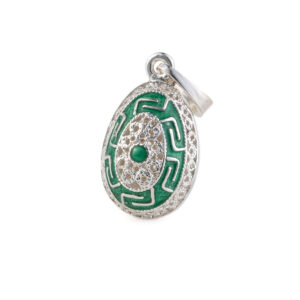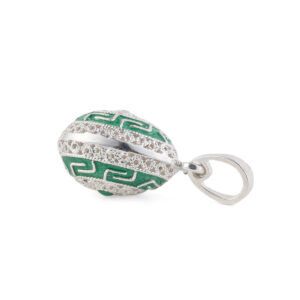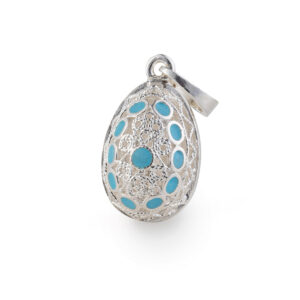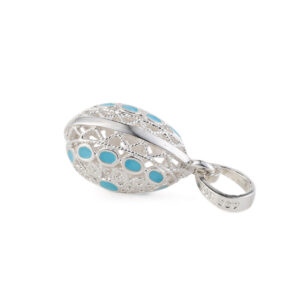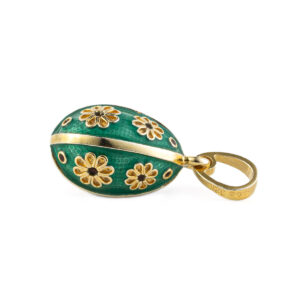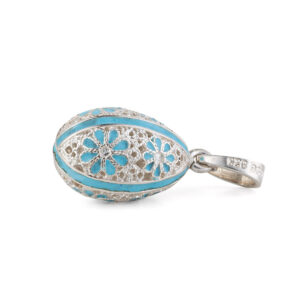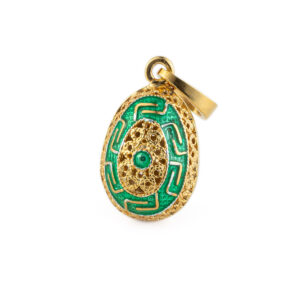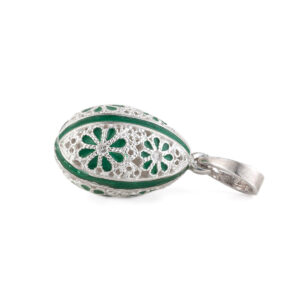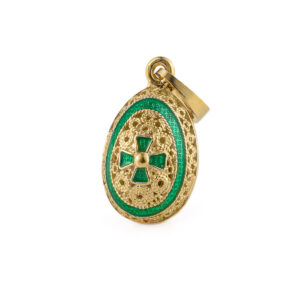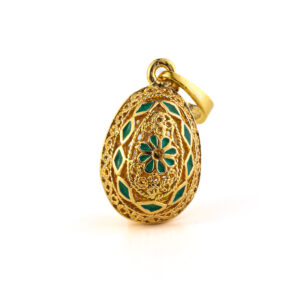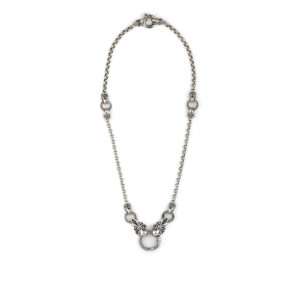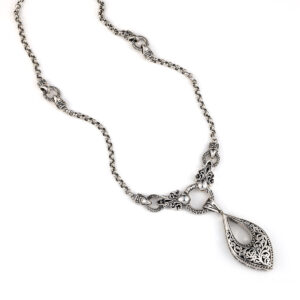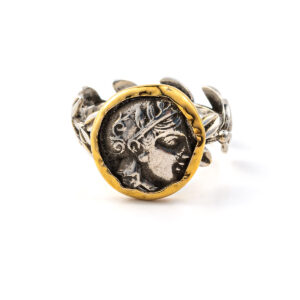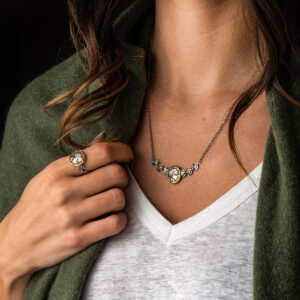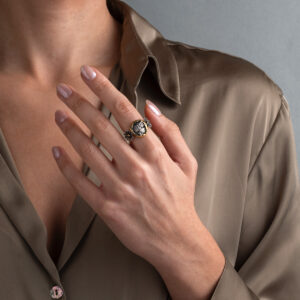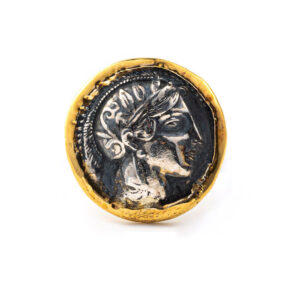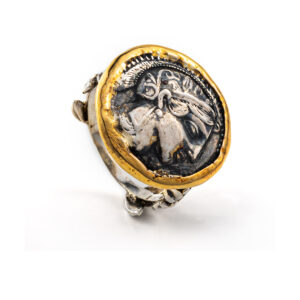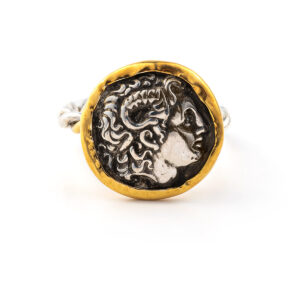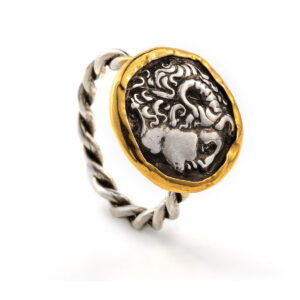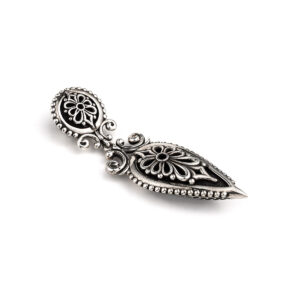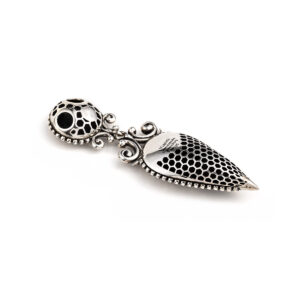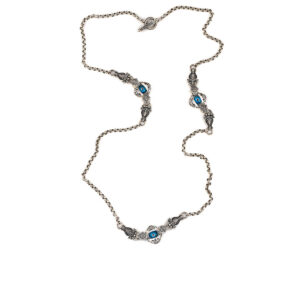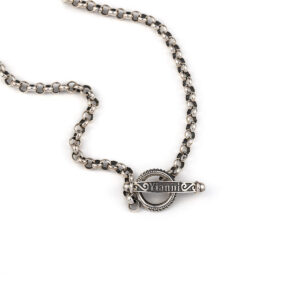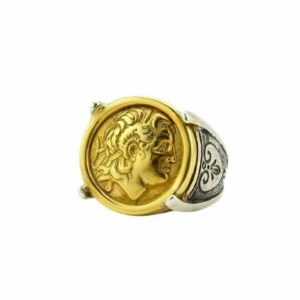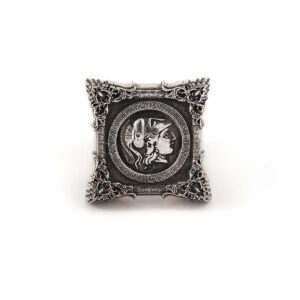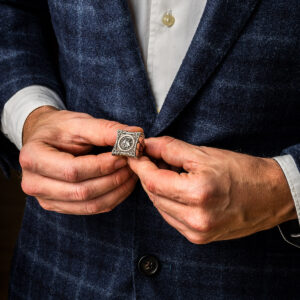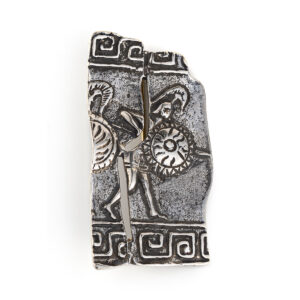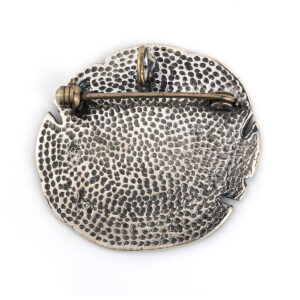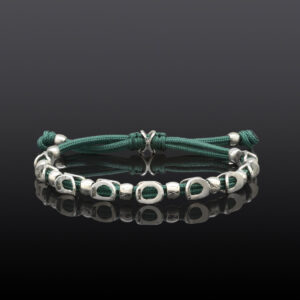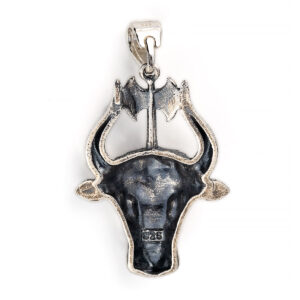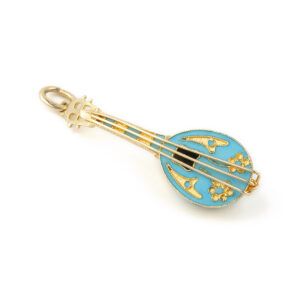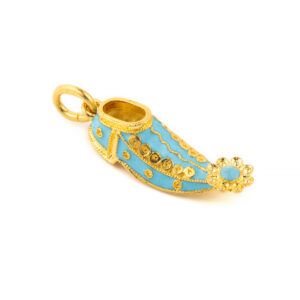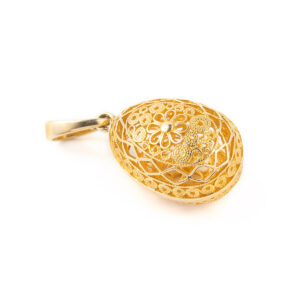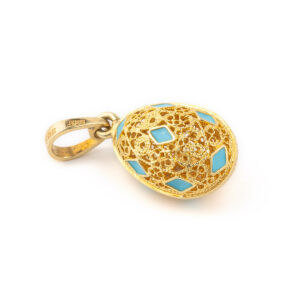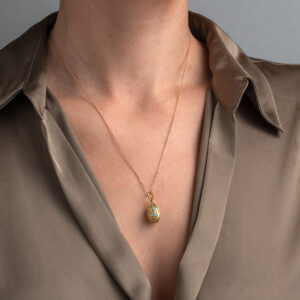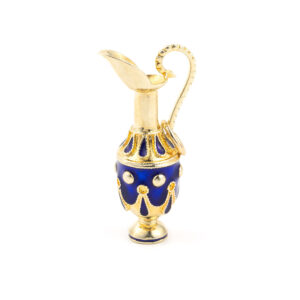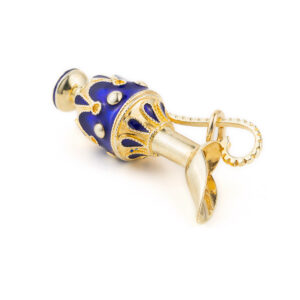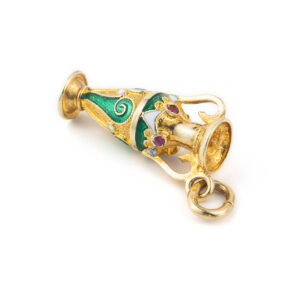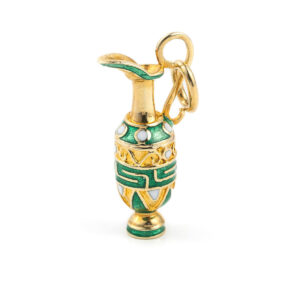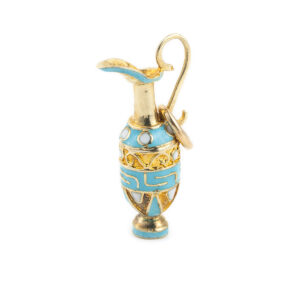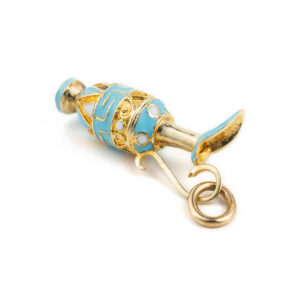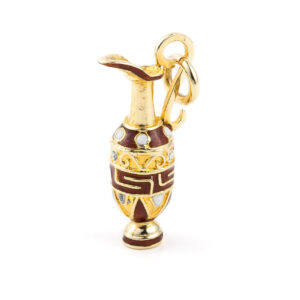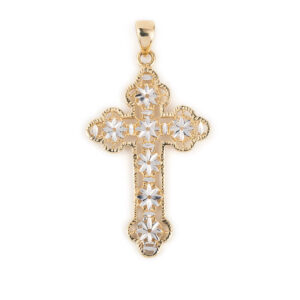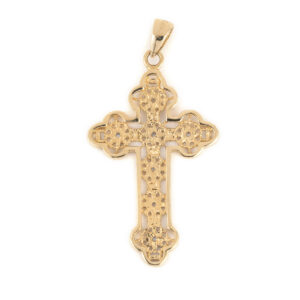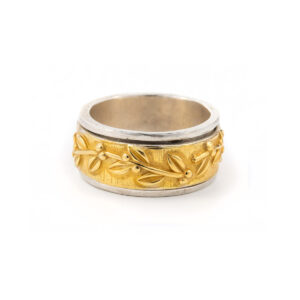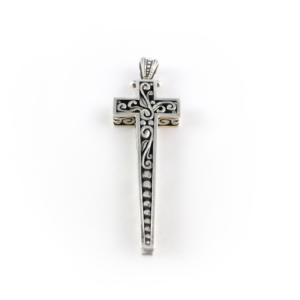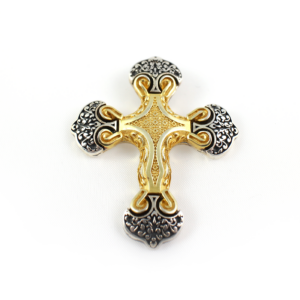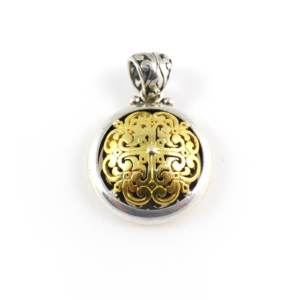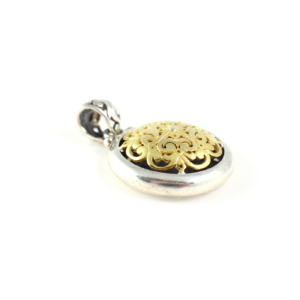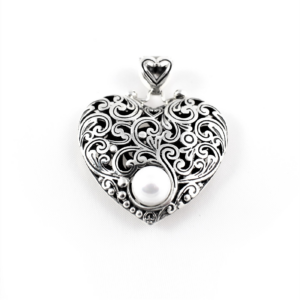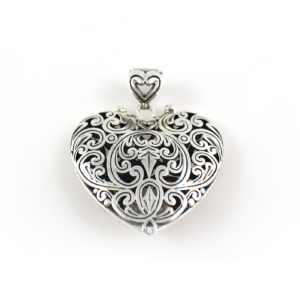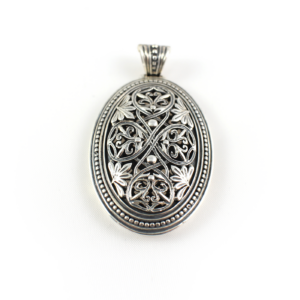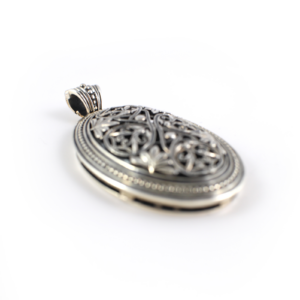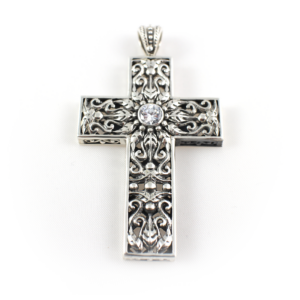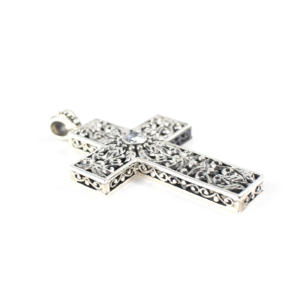Κολιέ με Μενταγιόν Μπουζούκι με Μπλε Σμάλτο – Ασήμι 925
Greek Bouzouki Charm with enamel. The pendant is decorated with rosette motifs.
Made of sterling silver.
Handmade item.
Design inspired by the Greek tradition.
Κολιέ με Μενταγιόν Αυγό – Ασήμι 925
The pendant is embellished with a fine filigree and enamel in Faberge style.
Made of 925 sterling silver.
Handmade in Greece.
The chain shown is included.
Filigree is a delicate kind of jewellery metalwork, made with tiny beads or twisted threads, or both in combination, soldered together or to the surface of an object of the same metal and arranged in artistic motifs. The art of filigree dates back to ancient history. The first of the found jewelry in this technique have been found in Mesopotamia and dates to thousands of years BC. In the ancient world and particularly in Asia Minor, this art grew were at the highest level.
Fabergé egg is a jeweled egg created by the House of Fabergé, in St. Petersburg, Imperial Russia. Virtually all were manufactured under the supervision of Peter Carl Fabergé between 1885 and 1917,[citation needed] the most famous being the 50 “Imperial” eggs, 43 of which survive, made for the Russian Tsars Alexander III and Nicholas II as Easter gifts for their wives and mothers. The first Fabergé egg was crafted for Tsar Alexander III, who had decided to give his wife, the Empress Maria Feodorovna, an Easter egg in 1885. Peter Carl Fabergé was a Russian jeweller best known for the famous Fabergé eggs made in the style of genuine Easter eggs, using precious metals and gemstones. He’s the founder of the famous jewelry legacy House of Fabergé.
Κολιέ με Μενταγιόν Αυγό – Ασήμι 925
The pendant is embellished with a fine filigree and enamel in Faberge style.
Made of 925 sterling silver.
Handmade in Greece.
The chain shown is included.
Filigree is a delicate kind of jewellery metalwork, made with tiny beads or twisted threads, or both in combination, soldered together or to the surface of an object of the same metal and arranged in artistic motifs. The art of filigree dates back to ancient history. The first of the found jewelry in this technique have been found in Mesopotamia and dates to thousands of years BC. In the ancient world and particularly in Asia Minor, this art grew were at the highest level.
Fabergé egg is a jeweled egg created by the House of Fabergé, in St. Petersburg, Imperial Russia. Virtually all were manufactured under the supervision of Peter Carl Fabergé between 1885 and 1917,[citation needed] the most famous being the 50 “Imperial” eggs, 43 of which survive, made for the Russian Tsars Alexander III and Nicholas II as Easter gifts for their wives and mothers. The first Fabergé egg was crafted for Tsar Alexander III, who had decided to give his wife, the Empress Maria Feodorovna, an Easter egg in 1885. Peter Carl Fabergé was a Russian jeweller best known for the famous Fabergé eggs made in the style of genuine Easter eggs, using precious metals and gemstones. He’s the founder of the famous jewelry legacy House of Fabergé.
Κολιέ με Μενταγιόν Αυγό – Ασήμι 925
The pendant is embellished with a fine filigree and enamel in Faberge style.
Made of 925 sterling silver.
Handmade in Greece.
The chain shown is included.
Filigree is a delicate kind of jewellery metalwork, made with tiny beads or twisted threads, or both in combination, soldered together or to the surface of an object of the same metal and arranged in artistic motifs. The art of filigree dates back to ancient history. The first of the found jewelry in this technique have been found in Mesopotamia and dates to thousands of years BC. In the ancient world and particularly in Asia Minor, this art grew were at the highest level.
Fabergé egg is a jeweled egg created by the House of Fabergé, in St. Petersburg, Imperial Russia. Virtually all were manufactured under the supervision of Peter Carl Fabergé between 1885 and 1917,[citation needed] the most famous being the 50 “Imperial” eggs, 43 of which survive, made for the Russian Tsars Alexander III and Nicholas II as Easter gifts for their wives and mothers. The first Fabergé egg was crafted for Tsar Alexander III, who had decided to give his wife, the Empress Maria Feodorovna, an Easter egg in 1885. Peter Carl Fabergé was a Russian jeweller best known for the famous Fabergé eggs made in the style of genuine Easter eggs, using precious metals and gemstones. He’s the founder of the famous jewelry legacy House of Fabergé.
Κολιέ με Μενταγιόν Αυγό – Ασήμι 925
The pendant is embellished with a fine filigree and enamel in Faberge style.
Made of 925 sterling silver.
Handmade in Greece.
The chain shown is included.
Filigree is a delicate kind of jewellery metalwork, made with tiny beads or twisted threads, or both in combination, soldered together or to the surface of an object of the same metal and arranged in artistic motifs. The art of filigree dates back to ancient history. The first of the found jewelry in this technique have been found in Mesopotamia and dates to thousands of years BC. In the ancient world and particularly in Asia Minor, this art grew were at the highest level.
Fabergé egg is a jeweled egg created by the House of Fabergé, in St. Petersburg, Imperial Russia. Virtually all were manufactured under the supervision of Peter Carl Fabergé between 1885 and 1917,[citation needed] the most famous being the 50 “Imperial” eggs, 43 of which survive, made for the Russian Tsars Alexander III and Nicholas II as Easter gifts for their wives and mothers. The first Fabergé egg was crafted for Tsar Alexander III, who had decided to give his wife, the Empress Maria Feodorovna, an Easter egg in 1885. Peter Carl Fabergé was a Russian jeweller best known for the famous Fabergé eggs made in the style of genuine Easter eggs, using precious metals and gemstones. He’s the founder of the famous jewelry legacy House of Fabergé.
Κολιέ με Μενταγιόν Αυγό – Ασήμι 925
The pendant is embellished with a fine filigree and enamel in Faberge style.
Made of 925 sterling silver.
Handmade in Greece.
The chain shown is included.
Filigree is a delicate kind of jewellery metalwork, made with tiny beads or twisted threads, or both in combination, soldered together or to the surface of an object of the same metal and arranged in artistic motifs. The art of filigree dates back to ancient history. The first of the found jewelry in this technique have been found in Mesopotamia and dates to thousands of years BC. In the ancient world and particularly in Asia Minor, this art grew were at the highest level.
Fabergé egg is a jeweled egg created by the House of Fabergé, in St. Petersburg, Imperial Russia. Virtually all were manufactured under the supervision of Peter Carl Fabergé between 1885 and 1917,[citation needed] the most famous being the 50 “Imperial” eggs, 43 of which survive, made for the Russian Tsars Alexander III and Nicholas II as Easter gifts for their wives and mothers. The first Fabergé egg was crafted for Tsar Alexander III, who had decided to give his wife, the Empress Maria Feodorovna, an Easter egg in 1885. Peter Carl Fabergé was a Russian jeweller best known for the famous Fabergé eggs made in the style of genuine Easter eggs, using precious metals and gemstones. He’s the founder of the famous jewelry legacy House of Fabergé.
Κολιέ με Μενταγιόν Αυγό – Ασήμι 925
The pendant is embellished with a fine filigree and enamel in Faberge style.
Made of 925 sterling silver.
Handmade in Greece.
The chain shown is included.
Filigree is a delicate kind of jewellery metalwork, made with tiny beads or twisted threads, or both in combination, soldered together or to the surface of an object of the same metal and arranged in artistic motifs. The art of filigree dates back to ancient history. The first of the found jewelry in this technique have been found in Mesopotamia and dates to thousands of years BC. In the ancient world and particularly in Asia Minor, this art grew were at the highest level.
Fabergé egg is a jeweled egg created by the House of Fabergé, in St. Petersburg, Imperial Russia. Virtually all were manufactured under the supervision of Peter Carl Fabergé between 1885 and 1917,[citation needed] the most famous being the 50 “Imperial” eggs, 43 of which survive, made for the Russian Tsars Alexander III and Nicholas II as Easter gifts for their wives and mothers. The first Fabergé egg was crafted for Tsar Alexander III, who had decided to give his wife, the Empress Maria Feodorovna, an Easter egg in 1885. Peter Carl Fabergé was a Russian jeweller best known for the famous Fabergé eggs made in the style of genuine Easter eggs, using precious metals and gemstones. He’s the founder of the famous jewelry legacy House of Fabergé.
Κολιέ με Μενταγιόν Αυγό – Ασήμι 925
The pendant is embellished with a fine filigree and enamel in Faberge style.
Made of 925 sterling silver.
Handmade in Greece.
The chain shown is included.
Filigree is a delicate kind of jewellery metalwork, made with tiny beads or twisted threads, or both in combination, soldered together or to the surface of an object of the same metal and arranged in artistic motifs. The art of filigree dates back to ancient history. The first of the found jewelry in this technique have been found in Mesopotamia and dates to thousands of years BC. In the ancient world and particularly in Asia Minor, this art grew were at the highest level.
Fabergé egg is a jeweled egg created by the House of Fabergé, in St. Petersburg, Imperial Russia. Virtually all were manufactured under the supervision of Peter Carl Fabergé between 1885 and 1917,[citation needed] the most famous being the 50 “Imperial” eggs, 43 of which survive, made for the Russian Tsars Alexander III and Nicholas II as Easter gifts for their wives and mothers. The first Fabergé egg was crafted for Tsar Alexander III, who had decided to give his wife, the Empress Maria Feodorovna, an Easter egg in 1885. Peter Carl Fabergé was a Russian jeweller best known for the famous Fabergé eggs made in the style of genuine Easter eggs, using precious metals and gemstones. He’s the founder of the famous jewelry legacy House of Fabergé.
Κολιέ με Μενταγιόν Αυγό – Ασήμι 925 Επιχρυσωμένο
The pendant is embellished with a fine filigree and enamel in Faberge style.
Made of 925 sterling silver and gold plated.
Handmade in Greece.
The chain shown is included.
Filigree is a delicate kind of jewellery metalwork, made with tiny beads or twisted threads, or both in combination, soldered together or to the surface of an object of the same metal and arranged in artistic motifs. The art of filigree dates back to ancient history. The first of the found jewelry in this technique have been found in Mesopotamia and dates to thousands of years BC. In the ancient world and particularly in Asia Minor, this art grew were at the highest level.
Fabergé egg is a jeweled egg created by the House of Fabergé, in St. Petersburg, Imperial Russia. Virtually all were manufactured under the supervision of Peter Carl Fabergé between 1885 and 1917,[citation needed] the most famous being the 50 “Imperial” eggs, 43 of which survive, made for the Russian Tsars Alexander III and Nicholas II as Easter gifts for their wives and mothers. The first Fabergé egg was crafted for Tsar Alexander III, who had decided to give his wife, the Empress Maria Feodorovna, an Easter egg in 1885. Peter Carl Fabergé was a Russian jeweller best known for the famous Fabergé eggs made in the style of genuine Easter eggs, using precious metals and gemstones. He’s the founder of the famous jewelry legacy House of Fabergé.
Κολιέ με Μενταγιόν Αυγό – Ασήμι 925
The pendant is embellished with a fine filigree and enamel in Faberge style.
Made of 925 sterling silver.
Handmade in Greece.
The chain shown is included.
Filigree is a delicate kind of jewellery metalwork, made with tiny beads or twisted threads, or both in combination, soldered together or to the surface of an object of the same metal and arranged in artistic motifs. The art of filigree dates back to ancient history. The first of the found jewelry in this technique have been found in Mesopotamia and dates to thousands of years BC. In the ancient world and particularly in Asia Minor, this art grew were at the highest level.
Fabergé egg is a jeweled egg created by the House of Fabergé, in St. Petersburg, Imperial Russia. Virtually all were manufactured under the supervision of Peter Carl Fabergé between 1885 and 1917,[citation needed] the most famous being the 50 “Imperial” eggs, 43 of which survive, made for the Russian Tsars Alexander III and Nicholas II as Easter gifts for their wives and mothers. The first Fabergé egg was crafted for Tsar Alexander III, who had decided to give his wife, the Empress Maria Feodorovna, an Easter egg in 1885. Peter Carl Fabergé was a Russian jeweller best known for the famous Fabergé eggs made in the style of genuine Easter eggs, using precious metals and gemstones. He’s the founder of the famous jewelry legacy House of Fabergé.
Κολιέ με Μενταγιόν Αυγό – Ασήμι 925 Επιχρυσωμένο
The pendant is embellished with a fine filigree and enamel in Faberge style.
Made of 925 sterling silver and gold plated.
Handmade in Greece.
The chain shown is included.
Filigree is a delicate kind of jewellery metalwork, made with tiny beads or twisted threads, or both in combination, soldered together or to the surface of an object of the same metal and arranged in artistic motifs. The art of filigree dates back to ancient history. The first of the found jewelry in this technique have been found in Mesopotamia and dates to thousands of years BC. In the ancient world and particularly in Asia Minor, this art grew were at the highest level.
Fabergé egg is a jeweled egg created by the House of Fabergé, in St. Petersburg, Imperial Russia. Virtually all were manufactured under the supervision of Peter Carl Fabergé between 1885 and 1917,[citation needed] the most famous being the 50 “Imperial” eggs, 43 of which survive, made for the Russian Tsars Alexander III and Nicholas II as Easter gifts for their wives and mothers. The first Fabergé egg was crafted for Tsar Alexander III, who had decided to give his wife, the Empress Maria Feodorovna, an Easter egg in 1885. Peter Carl Fabergé was a Russian jeweller best known for the famous Fabergé eggs made in the style of genuine Easter eggs, using precious metals and gemstones. He’s the founder of the famous jewelry legacy House of Fabergé.
Κολιέ με Μενταγιόν Αυγό – Ασήμι 925
The pendant is embellished with a fine filigree and enamel in Faberge style.
Made of 925 sterling silver.
Handmade in Greece.
The chain shown is included.
Filigree is a delicate kind of jewellery metalwork, made with tiny beads or twisted threads, or both in combination, soldered together or to the surface of an object of the same metal and arranged in artistic motifs. The art of filigree dates back to ancient history. The first of the found jewelry in this technique have been found in Mesopotamia and dates to thousands of years BC. In the ancient world and particularly in Asia Minor, this art grew were at the highest level.
Fabergé egg is a jeweled egg created by the House of Fabergé, in St. Petersburg, Imperial Russia. Virtually all were manufactured under the supervision of Peter Carl Fabergé between 1885 and 1917,[citation needed] the most famous being the 50 “Imperial” eggs, 43 of which survive, made for the Russian Tsars Alexander III and Nicholas II as Easter gifts for their wives and mothers. The first Fabergé egg was crafted for Tsar Alexander III, who had decided to give his wife, the Empress Maria Feodorovna, an Easter egg in 1885. Peter Carl Fabergé was a Russian jeweller best known for the famous Fabergé eggs made in the style of genuine Easter eggs, using precious metals and gemstones. He’s the founder of the famous jewelry legacy House of Fabergé.
Κολιέ με Μενταγιόν Αυγό – Ασήμι 925 Επιχρυσωμένο
The pendant is embellished with a fine filigree and enamel in Faberge style.
Made of 925 sterling silver and gold plated.
Handmade in Greece.
The chain shown is included.
Filigree is a delicate kind of jewellery metalwork, made with tiny beads or twisted threads, or both in combination, soldered together or to the surface of an object of the same metal and arranged in artistic motifs. The art of filigree dates back to ancient history. The first of the found jewelry in this technique have been found in Mesopotamia and dates to thousands of years BC. In the ancient world and particularly in Asia Minor, this art grew were at the highest level.
Fabergé egg is a jeweled egg created by the House of Fabergé, in St. Petersburg, Imperial Russia. Virtually all were manufactured under the supervision of Peter Carl Fabergé between 1885 and 1917,[citation needed] the most famous being the 50 “Imperial” eggs, 43 of which survive, made for the Russian Tsars Alexander III and Nicholas II as Easter gifts for their wives and mothers. The first Fabergé egg was crafted for Tsar Alexander III, who had decided to give his wife, the Empress Maria Feodorovna, an Easter egg in 1885. Peter Carl Fabergé was a Russian jeweller best known for the famous Fabergé eggs made in the style of genuine Easter eggs, using precious metals and gemstones. He’s the founder of the famous jewelry legacy House of Fabergé.
Κολιέ με Μενταγιόν Αυγό – Ασήμι 925 Επιχρυσωμένο
The pendant is embellished with a fine filigree and enamel in Faberge style.
Made of 925 sterling silver and gold plated.
Handmade in Greece.
The chain shown is included.
Filigree is a delicate kind of jewellery metalwork, made with tiny beads or twisted threads, or both in combination, soldered together or to the surface of an object of the same metal and arranged in artistic motifs. The art of filigree dates back to ancient history. The first of the found jewelry in this technique have been found in Mesopotamia and dates to thousands of years BC. In the ancient world and particularly in Asia Minor, this art grew were at the highest level.
Fabergé egg is a jeweled egg created by the House of Fabergé, in St. Petersburg, Imperial Russia. Virtually all were manufactured under the supervision of Peter Carl Fabergé between 1885 and 1917,[citation needed] the most famous being the 50 “Imperial” eggs, 43 of which survive, made for the Russian Tsars Alexander III and Nicholas II as Easter gifts for their wives and mothers. The first Fabergé egg was crafted for Tsar Alexander III, who had decided to give his wife, the Empress Maria Feodorovna, an Easter egg in 1885. Peter Carl Fabergé was a Russian jeweller best known for the famous Fabergé eggs made in the style of genuine Easter eggs, using precious metals and gemstones. He’s the founder of the famous jewelry legacy House of Fabergé.
Βυζαντινό Κολιέ Ασήμι 925 – Yianni Jewelry
Made of 925⁰ sterling silver
Handmade item.
These silver creations of Yianni Jewelry, created by Garbis Khacherian, a silversmith trader since 1987.
Δαχτυλίδι Θεά Αθηνά με Ροζέτες – 14Κ Χρυσό και Ασήμι 925
Α beautiful ring with Goddess Athena decorated with rosettes.
Made in 14K gold and 925⁰ sterling silver.
Handmade item.
Goddess Athena – Athenian silver tetradrachm
Dracma was the currency used in Greece during several periods in its history.
The tetradrachm was an Ancient Greek silver coin equivalent to fourdrachmae in Athens it replaced the earlier “heraldic” type of didrachms and it was in wide circulation from ca. 510 to ca. 38 BC.
The front side of this coin is decorated with Goddess Athena. Athena is an ancient Greek goddess associated with wisdom, handicraft, and warfare.
Athena was regarded as the patron and protectress of various cities across Greece, particularly the city of Athens, from which she most likely received her name. She’s usually shown in art wearing a helmet and holding a spear. Her major symbols include owls, olive trees, and snakes. Her temples were located atop the fortified Acropolis in the central part of the city. The Parthenon on the Athenian Acropolis is dedicated to her, along with numerous other temples and monuments. Her main festival in Athens was the Panathenaia, which was celebrated in midsummer and was the most important festival on the Athenian calendar.
In the classical Olympian pantheon, Athena was regarded as the favorite daughter of Zeus.
The rosette (rose) is a timeless jewel, symbol and amulet. The origin of the term is the Greek word for rose – rodon (ρόδον). Its use began in the Mycenaean era and continues as far as the 2nd millennia BC. The Mycenaean Rosette is a motif that was widespread throughout Mesopotamia, Egypt, Greece and other ancient civilizations. It is inspired by a Mycenaean rosette bead, found at Mycenae, dated to 1400-1300 B.C. The rosette were used extensively in ancient Greek Mycenaean jewels, in architecture, pottery and in sculptures from 1500 BC. Mycenaean rosettes usually had 6 or 8 or 12 leaves, and sixteen leaves during the Macedonian Dynasty. Such details as the rodax shape and the number of leaves tend to vary with the era or beliefs. The rosettes were used to decorate the cloths, the belts and wreaths of the Kings. The number of leaves had a symbolic character each time. The four elements of nature (wind, earth, fire, water), the seven wonders of the ancient world or the twelve gods of ancient Greeks and the world domination and radiance of the Kings of Macedonia. They were signs of beauty, purity, eugenics, worship and power. Rosette or Rodax was probably the most popular and favorite decorative element in Mycenaean era, classical antiquity and Byzantine times.
Δαχτυλίδι Θεά Αθηνά – 14Κ Χρυσό και Ασήμι 925
Α beautiful ring with Goddess Athena decorated with olive leaves.
Made in 14K gold and 925⁰ sterling silver.
Handmade item.
Goddess Athena – Athenian silver tetradrachm
Dracma was the currency used in Greece during several periods in its history.
The tetradrachm was an Ancient Greek silver coin equivalent to fourdrachmae in Athens it replaced the earlier “heraldic” type of didrachms and it was in wide circulation from ca. 510 to ca. 38 BC.
The front side of this coin is decorated with Goddess Athena. Athena is an ancient Greek goddess associated with wisdom, handicraft, and warfare.
Athena was regarded as the patron and protectress of various cities across Greece, particularly the city of Athens, from which she most likely received her name. She’s usually shown in art wearing a helmet and holding a spear. Her major symbols include owls, olive trees, and snakes. Her temples were located atop the fortified Acropolis in the central part of the city. The Parthenon on the Athenian Acropolis is dedicated to her, along with numerous other temples and monuments. Her main festival in Athens was the Panathenaia, which was celebrated in midsummer and was the most important festival on the Athenian calendar.
In the classical Olympian pantheon, Athena was regarded as the favorite daughter of Zeus.
Δαχτυλίδι Θεά Αθηνά με Ροζέτες – 14Κ Χρυσό και Ασήμι 925
Α beautiful ring with Goddess Athena decorated with rosettes.
Made in 14K gold and 925⁰ sterling silver.
Handmade item.
Goddess Athena – Athenian silver tetradrachm
Dracma was the currency used in Greece during several periods in its history.
The tetradrachm was an Ancient Greek silver coin equivalent to fourdrachmae in Athens it replaced the earlier “heraldic” type of didrachms and it was in wide circulation from ca. 510 to ca. 38 BC.
The front side of this coin is decorated with Goddess Athena. Athena is an ancient Greek goddess associated with wisdom, handicraft, and warfare.
Athena was regarded as the patron and protectress of various cities across Greece, particularly the city of Athens, from which she most likely received her name. She’s usually shown in art wearing a helmet and holding a spear. Her major symbols include owls, olive trees, and snakes. Her temples were located atop the fortified Acropolis in the central part of the city. The Parthenon on the Athenian Acropolis is dedicated to her, along with numerous other temples and monuments. Her main festival in Athens was the Panathenaia, which was celebrated in midsummer and was the most important festival on the Athenian calendar.
In the classical Olympian pantheon, Athena was regarded as the favorite daughter of Zeus.
The rosette (rose) is a timeless jewel, symbol and amulet. The origin of the term is the Greek word for rose – rodon (ρόδον). Its use began in the Mycenaean era and continues as far as the 2nd millennia BC. The Mycenaean Rosette is a motif that was widespread throughout Mesopotamia, Egypt, Greece and other ancient civilizations. It is inspired by a Mycenaean rosette bead, found at Mycenae, dated to 1400-1300 B.C. The rosette were used extensively in ancient Greek Mycenaean jewels, in architecture, pottery and in sculptures from 1500 BC. Mycenaean rosettes usually had 6 or 8 or 12 leaves, and sixteen leaves during the Macedonian Dynasty. Such details as the rodax shape and the number of leaves tend to vary with the era or beliefs. The rosettes were used to decorate the cloths, the belts and wreaths of the Kings. The number of leaves had a symbolic character each time. The four elements of nature (wind, earth, fire, water), the seven wonders of the ancient world or the twelve gods of ancient Greeks and the world domination and radiance of the Kings of Macedonia. They were signs of beauty, purity, eugenics, worship and power. Rosette or Rodax was probably the most popular and favorite decorative element in Mycenaean era, classical antiquity and Byzantine times.
Δαχτυλίδι Θεά Αθηνά – 14Κ Χρυσό και Ασήμι 925
Α beautiful ring with Goddess Athena and wisdom owl.
Made in 14K gold and 925⁰ sterling silver.
Handmade item.
Goddess Athena – Athenian silver tetradrachm
Dracma was the currency used in Greece during several periods in its history.
The tetradrachm was an Ancient Greek silver coin equivalent to fourdrachmae in Athens it replaced the earlier “heraldic” type of didrachms and it was in wide circulation from ca. 510 to ca. 38 BC.
The front side of this coin is decorated with Goddess Athena. Athena is an ancient Greek goddess associated with wisdom, handicraft, and warfare.
Athena was regarded as the patron and protectress of various cities across Greece, particularly the city of Athens, from which she most likely received her name. She’s usually shown in art wearing a helmet and holding a spear. Her major symbols include owls, olive trees, and snakes. Her temples were located atop the fortified Acropolis in the central part of the city. The Parthenon on the Athenian Acropolis is dedicated to her, along with numerous other temples and monuments. Her main festival in Athens was the Panathenaia, which was celebrated in midsummer and was the most important festival on the Athenian calendar.
In the classical Olympian pantheon, Athena was regarded as the favorite daughter of Zeus.
Δαχτυλίδι Μέγας Αλέξανδρος – 14Κ Χρυσό και Ασήμι 925
This Ancient Greek coin represent Alexander the great one one side and king Lysimachus on the other.
Handmade item.
Made of 925°sterling silver and 14k gold.
Alexander the Great the King of Macedonia is considered one of the most important forms of world history. Alexander III of Macedon, commonly known as Alexander the Great, was a king of the ancient Greek kingdom of Macedon. He was born in Pella in 356 BC and succeeded his father Philip II to the throne at the age of 20. Alexander the Great is considered one of the most important forms of world history. Lysimachus was a Macedonian officer and diadochus of Alexander the Great, who became a basileus in 306 BC, ruling Thrace, Asia Minor and Macedon.
Βυζαντινός Σταυρός Anthemion Ασήμι 925 – Yianni Jewelry
This pendant is inspired from the greek antefix ornament.
Made of 925° sterling silver.
Handmade pendant.
These silver creations of Yianni Jewelry, created by Garbis Khacherian, a silversmith trader since 1987.
Βυζαντινό Κολιέ Ασήμι 925 – Yianni Jewelry
Made in 925° sterling silver.
Handmade item.
These silver creations of Yianni Jewelry, created by Garbis Khacherian, a silversmith trader since 1987.
Δαχτυλίδι με Μέγα Αλέξανδρο – Επιχρυσωμένο Ασήμι 925
This Ancient Greek coin represent Alexander the great.
Handmade item.
Made in 925°sterling silver and gold plated.
Alexander the Great the King of Macedonia is considered one of the most important forms of world history. Alexander III of Macedon, commonly known as Alexander the Great, was a king of the ancient Greek kingdom of Macedon. He was born in Pella in 356 BC and succeeded his father Philip II to the throne at the age of 20. Alexander the Great is considered one of the most important forms of world history. Lysimachus was a Macedonian officer and diadochus of Alexander the Great, who became a basileus in 306 BC, ruling Thrace, Asia Minor and Macedon.
Δαχτυλίδι με Θεά Αθηνά από Ασήμι 925 – Yianni Jewelry
Α beautiful ring with Goddess Athena
Made of 925⁰ sterling silver.
Goddess Athena – Athenian silver tetradrachm
Dracma was the currency used in Greece during several periods in its history.
The tetradrachm was an Ancient Greek silver coin equivalent to fourdrachmae in Athens it replaced the earlier “heraldic” type of didrachms and it was in wide circulation from ca. 510 to ca. 38 BC.
The front side of this coin is decorated with Goddess Athena. Athena is an ancient Greek goddess associated with wisdom, handicraft, and warfare.
Athena was regarded as the patron and protectress of various cities across Greece, particularly the city of Athens, from which she most likely received her name. She’s usually shown in art wearing a helmet and holding a spear. Her major symbols include owls, olive trees, and snakes. Her temples were located atop the fortified Acropolis in the central part of the city. The Parthenon on the Athenian Acropolis is dedicated to her, along with numerous other temples and monuments. Her main festival in Athens was the Panathenaia, which was celebrated in midsummer and was the most important festival on the Athenian calendar.
In the classical Olympian pantheon, Athena was regarded as the favorite daughter of Zeus.
Καρφίτσα Λεωνίδας – Ασήμι 925
This handmade sterling silver brooch depicting ‘Leonidas’.
Made in 925⁰ sterling silver. Oxidized finish.
Handmade item.
Leonidas was a warrior king of the Greek city-state of Sparta. Arguably, one of the greatest heroes in the history of ancient Greece. In 480 B.C Leonidas led an army of 6,000 to 7,000 Greeks from many city-states, including 300 Spartans, fought the invading Persian army at the pass of Thermopylae. Leonidas of Sparta blocked the only road through which the massive army of Xerxes could pass. The Persians succeeded in defeating the Greeks but sustained heavy losses. A local resident named Ephialtes led the Persian general by a mountain track to the rear of the Greeks. King Leonidas sent away all the Greek troops and stayed behind with 300 Spartans, 400 Thebans, and 700 Thespian volunteers who refused to leave. They were all killed in the battlefield, protecting their homeland.
Καρφίτσα Κουκουβάγια – Ασήμι 925
A beautiful brooch with the wisdom owl.
Made in 925⁰ sterling silver. Oxidized finish.
Handmade item.
Καρφίτσα Κίονας – Ασήμι 925
Made in 925⁰ sterling silver. Oxidized finish.
Handmade item.
There are three distinct orders in Ancient Greek architecture: Doric, Ionic, and Corinthian. The Ionic capital is characterized by the use of volutes. The Ionic columns normally stand on a base which separates the shaft of the column from the stylobate or platform; the cap is usually enriched with egg-and-dart. It was a popular style in Athens.
Βραχιόλι με Κρίκους και Κορδόνι – Ασήμι 925
Κατασκευασμένο από ασήμι 925 και κορδόνι.
Το μέγεθος του βραχιολιού προσαρμόζεται.
Χειροποίητο ελληνικό κόσμημα.
Μενταγιόν Γαϊδουράκι – Ασήμι 925
By the second millennium BC, the donkey was brought to Europe, possibly at the same time as viticulture was introduced, as the donkey is associated with the Syrian god of wine, Dionysus.
Used as a charm on a bracelet or as a pendant on a chain.
Made of 925 sterling silver.
Handmade item.
Μενταγιόν Μινώταυρος – Ασήμι 925
Ancient Minoan Cretan Pendant with Minotaur and Double Axe.
In Greek mythology, the Minotaur is a mythical creature portrayed in Classical times with the head and tail of a bull and the body of a man. He dwelt at the center of the Labyrinth, which was an elaborate maze-like construction designed by the architect Daedalus and his son Icarus, on the command of King Minos of Crete. The Minotaur was eventually killed by the Athenian hero Theseus.
Made of 925 sterling silver.
Handmade item.
Μενταγιόν Μπουζούκι – 14Κ Χρυσό
920,00€Greek Bouzouki Charm with turquoise enamel. The pendant is decorated with rosette motifs.
Made in 14k yellow gold.
Used as a charm or as a pendant.
Design inspired by the Greek tradition
The Greek bouzouki is a plucked musical instrument of the lute family, called the thabouras or tambouras family. The tambouras has existed in ancient Greece as pandoura, and can be found in various sizes and shapes. The bouzouki and the baglamas are the direct descendants. The bouzouki arrived in Greece following the 1919–1922 war in Asia Minor and the subsequent exchange of populations between Greece and Turkey when the ethnic Greeks fled to Greece. At the end of the 1950s, four-course (tetrachordo) bouzoukia started to gain popularity. The four-course bouzouki was made popular by Manolis Chiotis. Manolis Chiotis was a Greek rebetiko and laiko composer, singer, and bouzouki player. He is considered one of the greatest bouzouki soloists of all time. In the summer of 1961, he played for Aristotle Onassis and Maria Callas and Grace Kelly. Callas told Chiotis that she had been translating the lyrics of his songs to Princess Grace all night long and the American actress loved them because “she is a woman in love.” At that moment, Kelly asked Chiotis what the difference between a bouzouki and an electric guitar is. Chiotis’ answer was rather unexpected; “Mrs. Callas, please explain to Princess Grace that the strings of an electric guitar vibrate due to electricity, while the strings of a bouzouki vibrate through the heart.” *
The rosette (rose) is a timeless jewel, symbol and amulet. The origin of the term is the Greek word for rose – rodon (ρόδον). Its use began in the Mycenaean era and continues as far as the 2nd millennia BC. The Mycenaean Rosette is a motif that was widespread throughout Mesopotamia, Egypt, Greece and other ancient civilizations. Rosette or Rodax was probably the most popular and favorite decorative element in Mycenaean era, classical antiquity and Byzantine times.
Μενταγιόν Τσαρούχι – 14Κ Χρυσό
620,00€Have you witnessed the changing of the guards in Syntagma square? This is the most traditional shoe of Greece (tsarouhi). The pendant is decorated with turquoise enamel and rosette motif. The rosette (rose) is a timeless jewel, symbol and amulet. The origin of the term is the Greek word for rose – rodon (ρόδον). Its use began in the Mycenaean era and continues as far as the 2nd millennia BC. The Mycenaean Rosette is a motif that was widespread throughout Mesopotamia, Egypt, Greece and other ancient civilizations. Rosette or Rodax was probably the most popular and favorite decorative element in Mycenaean era, classical antiquity and Byzantine times.
Made in 14k yellow gold.
Used as a charm or as a pendant.
Design inspired by the Greek tradition
A tsarouchi (τσαρούχι) is a type of shoe, which is typically known nowadays as part of the traditional uniform worn by the Evzones of the Greek Presidential Guard. Their origin goes back to the Byzantine times. Originally, various types of similar shoes were worn all over the Balkans, but tsarouchia are mainly associated with the Greeks. They were the most common footwear worn by both urban and rural Greeks, mainly men, but also many women. After the Greek independence in early 19th century, their use was limited to isolated rural areas and nomadic populations. Tsarouciia provide a clear link with the origin of the Evzone uniform in the traditional Greek costume, and with the fact that Evzones were largely enlisted from rural mountainous regions of Greece. Nowadays they are almost exclusively used by the presidential guard and in various traditional festivals and dances along with other traditional Greek garments.(source wikipedia)
Μενταγιόν Αμφορέας – 14Κ Χρυσό
1.648,00€Ancient Greek Amphora Pendant with blue enamel.
Design inspired by the ancient Greek history.
Made in 14k yellow gold
Also available with turquoise or green enamel
Handmade item
Amphora is a Greco – Roman word developed in ancient Greek during the Bronze Age. An amphora is a type of container of a characteristic shape and size. Amphorae were used for the transport and storage of various products, both liquid and dry, but mostly for wine. They are most often ceramic. the amphorae used in Ancient Greek vase painting. (source wikipedia)
Μενταγιόν Αμφορέας – 14Κ Χρυσό
592,00€Ancient Greek Amphora Pendant with turquoise enamel.
Design inspired by the ancient Greek history.
Made in 14k yellow gold
Also available with red or green enamel
Handmade item
Amphora is a Greco – Roman word developed in ancient Greek during the Bronze Age. An amphora is a type of container of a characteristic shape and size. Amphorae were used for the transport and storage of various products, both liquid and dry, but mostly for wine. They are most often ceramic. the amphorae used in Ancient Greek vase painting.
Μενταγιόν Αμφορέας – 14Κ Χρυσό
620,00€Ancient Greek Amphora Pendant with green enamel.
Design inspired by the ancient Greek history.
Made in 14k yellow gold
Also available with red or turquoise enamel
Handmade item
Amphora is a Greco – Roman word developed in ancient Greek during the Bronze Age. An amphora is a type of container of a characteristic shape and size. Amphorae were used for the transport and storage of various products, both liquid and dry, but mostly for wine. They are most often ceramic. the amphorae used in Ancient Greek vase painting. (source wikipedia)
Μενταγιόν Αμφορέας – 14Κ Χρυσό
592,00€Ancient Greek Amphora Pendant with green enamel and Meander design.
Design inspired by the ancient Greek history.
Made in 14k yellow gold
Also available with red or turquoise enamel
Available in 3 sizes
Handmade item
As in all handmade items there may be small differences in weight and dimensions and this is what makes them unique and precious.
Amphora is a Greco – Roman word developed in ancient Greek during the Bronze Age. An amphora is a type of container of a characteristic shape and size. Amphorae were used for the transport and storage of various products, both liquid and dry, but mostly for wine. They are most often ceramic. the amphorae used in Ancient Greek vase painting. (source wikipedia)
Meander or Meandros design, one of the most historic symbols of the Greek World, also called Greek Key and symbolizes long life and eternity. The pattern with Meander was used in antiquity to decorate the frieze of temples.
Μενταγιόν Αμφορέας – 14Κ Χρυσό
592,00€Ancient Greek Amphora Pendant with Turquoise enamel and Meander design.
Design inspired by the ancient Greek history.
Made in 14k yellow gold
Also available with red or blue enamel
Available in 3 sizes
Handmade item
Amphora is a Greco – Roman word developed in ancient Greek during the Bronze Age. An amphora is a type of container of a characteristic shape and size. Amphorae were used for the transport and storage of various products, both liquid and dry, but mostly for wine. They are most often ceramic. the amphorae used in Ancient Greek vase painting. (source wikipedia)
Meander or Meandros design, one of the most historic symbols of the Greek World, also called Greek Key and symbolizes long life and eternity. The pattern with Meander was used in antiquity to decorate the frieze of temples.
Μενταγιόν Αμφορέας – 14Κ Χρυσό
620,00€Ancient Greek Amphora Pendant with red enamel and Meander design.
Design inspired by the ancient Greek history.
Made in 14k yellow gold
Also available with turquoise or blue enamel
Available in 3 sizes.
Handmade item.
The chain shown is our 14K Gold Chain (not included).
Amphora is a Greco – Roman word developed in ancient Greek during the Bronze Age. An amphora is a type of container of a characteristic shape and size. Amphorae were used for the transport and storage of various products, both liquid and dry, but mostly for wine. They are most often ceramic. the amphorae used in Ancient Greek vase painting. (source wikipedia)
Meander or Meandros design, one of the most historic symbols of the Greek World, also called Greek Key and symbolizes long life and eternity. The pattern with Meander was used in antiquity to decorate the frieze of temples.
Βυζαντινός Σταυρός – Χρυσό 14Κ
364,00€Byzantine Cross
Inspired by Byzantine art.
Made in 14k gold
Handmade item
Δαχτυλίδι Ελιά – Επιχρυσωμένο Ασήμι 925
Ancient Greek ring with olive leaves.
The olive tree in Ancient Greece was a symbol of the Olympic ideal, since an olive branch was the only prize for the Olympic champions. Τhe olive tree symbolizes peace, victory, honor and prosperity.
Handmade item.
Βυζαντινός Σταυρός Ασήμι 925 – Yianni Jewelry
This pendant inspired by Byzantine art.
Made in 925⁰ sterling silver
Handmade item.
These silver creations of Yianni Jewelry, created by Garbis Khacherian, a silversmith trader since 1987.
Βυζαντινός Σταυρός – Yianni Jewelry
Silver Cross Pendant with gold plated in the center.
This pendant inspired by Byzantine art.
Handmade item
These silver creations of Yianni Jewelry, created by Garbis Khacherian, a silversmith trader since 1987.
Βυζαντινός Μενταγιόν – Yianni Jewelry
Round pendant inspired by byzantine art.
Made in 925⁰ sterling silver and gold plated.
Handmade item.
These silver creations of Yianni Jewelry, created by Garbis Khacherian, a silversmith trader since 1987.
Βυζαντινό Μενταγιόν Καρδιά Ασήμι 925 – Yianni Jewelry
Byzantine Pendant with Pearl stone and granules of precious metal.
This technique called Granulation. Granulation (from Latin: granum = “grain”) is a jewellery technique whereby a surface of a jewel is covered with small spheres or granules of precious metal. The technique is thought to have its origins in Mesopotamia about 5,000 years ago.
Black oxidized background.
Design inspired by Byzantine Jewelry.
Made in 925⁰ sterling silver
Handmade item
These silver creations of Yianni Jewelry, created by Garbis Khacherian, a silversmith trader since 1987.
Βυζαντινό Μενταγιόν Ασήμι 925 – Yianni Jewelry
Byzantine Oval Pendant with floral motifs.
Black oxidized background.
The shape and decoration of this pendant shows the influence of the Byzantine art.
Made in 925⁰ sterling silver
Handmade item.
These silver creations of Yianni Jewelry, created by Garbis Khacherian, a silversmith trader since 1987.
Βυζαντινός Σταυρός Ασήμι 925 – Yianni Jewelry
Cross Pendant with one ruby.
This cross decorated with “akrokeramo” design. Akrokeramo is a decorative, architectural element known by Ancient Greece. It is the ultimate tile that held in place the remaining tiles. The most widespread is the amphitheater with the leaves of the palm tree (anthemio).
Inspired by Greek tradition & Byzantine art.
Made in 925⁰ sterling silver
Handmade item.
These silver creations of Yianni Jewelry, created by Garbis Khacherian, a silversmith trader since 1987.

